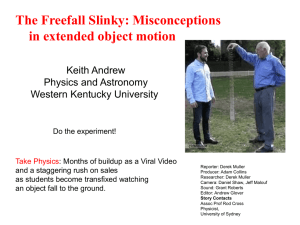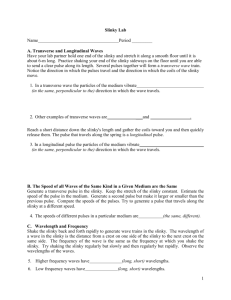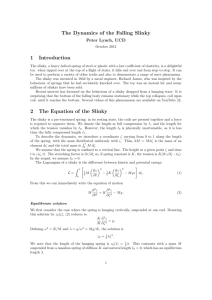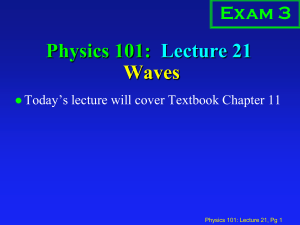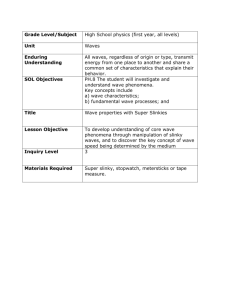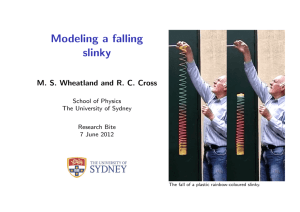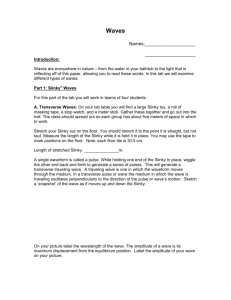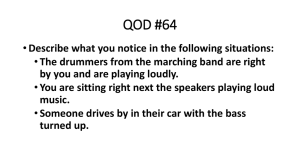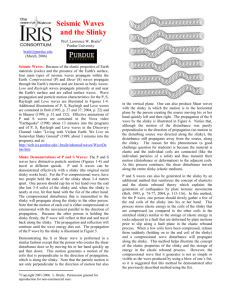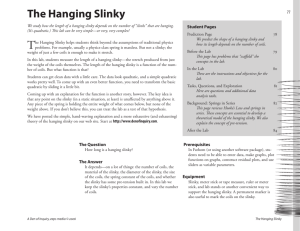Introduction to Waves
advertisement
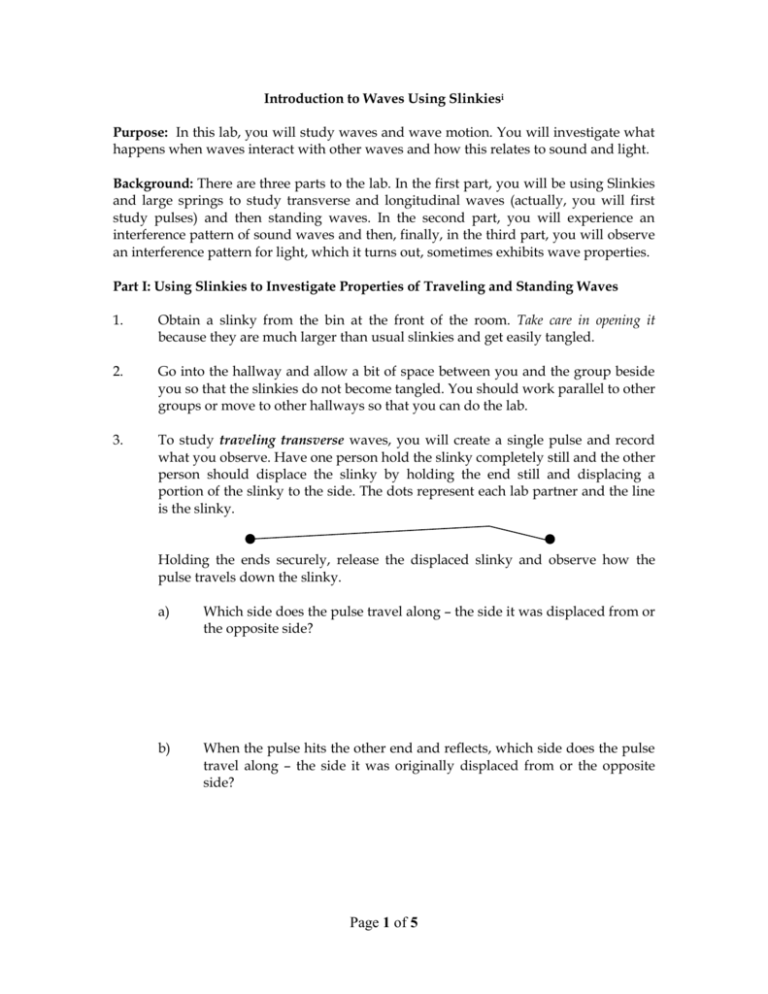
Introduction to Waves Using Slinkiesi Purpose: In this lab, you will study waves and wave motion. You will investigate what happens when waves interact with other waves and how this relates to sound and light. Background: There are three parts to the lab. In the first part, you will be using Slinkies and large springs to study transverse and longitudinal waves (actually, you will first study pulses) and then standing waves. In the second part, you will experience an interference pattern of sound waves and then, finally, in the third part, you will observe an interference pattern for light, which it turns out, sometimes exhibits wave properties. Part I: Using Slinkies to Investigate Properties of Traveling and Standing Waves 1. Obtain a slinky from the bin at the front of the room. Take care in opening it because they are much larger than usual slinkies and get easily tangled. 2. Go into the hallway and allow a bit of space between you and the group beside you so that the slinkies do not become tangled. You should work parallel to other groups or move to other hallways so that you can do the lab. 3. To study traveling transverse waves, you will create a single pulse and record what you observe. Have one person hold the slinky completely still and the other person should displace the slinky by holding the end still and displacing a portion of the slinky to the side. The dots represent each lab partner and the line is the slinky. Holding the ends securely, release the displaced slinky and observe how the pulse travels down the slinky. a) Which side does the pulse travel along – the side it was displaced from or the opposite side? b) When the pulse hits the other end and reflects, which side does the pulse travel along – the side it was originally displaced from or the opposite side? Page 1 of 5 4. Repeat to confirm your observations. Be sure to hold both ends still when doing this. 5. Repeat, only this time watch a single coil’s motion as the pulse travels back and forth along the slinky. Which way is the coil displaced – along the length of the slinky, perpendicular to the slinky, at some angle to the slinky? 6. To study traveling longitudinal waves, you will create a single pulse and record what you observe. Have one person hold the slinky completely still and the other person should gather several coils and pull them close to the end of the slinky. The result is that the coils are close together at one end of the slinky and far apart everywhere else. Holding on to the last five or so coils, release the other coils so that the compression can travel. 7. a) Record your observations of the pulse as it travels down the slinky. b) What happens when it reflects at the other end? Repeat, only this time watch a single coil’s motion as the pulse travels back and forth along the slinky. Which way is the coil displaced – along the length of the slinky, perpendicular to the slinky, at some angle to the slinky? Page 2 of 5 8. To study interference of pulses along traveling waves both partners will displace the slinky while holding the ends securely. Try to make the pulses of equal size, and make the pulses on the same side of the slinky. 9. a) What happens when the pulses hit each other? b) Now have one person make a larger pulse than the other person and allow the pulses to hit each other. What happens? Now you will make a standing wave. It is called a standing wave because it looks as though the wave is not traveling along the slinky and is standing still. You will know it when you see it. To do this, both partners will jiggle the end of the slinky at the same frequency and amplitude. You will have to experiment to make this happen. a) A node is a place where there is no displacement of the slinky. How many nodes do you count? b) An antinode is a place where there is maximum displacement of the slinky. How many antinodes do you count? Page 3 of 5 10. c) How many complete waves are on the slinky? Note that a complete wave looks like an “S” rather than a bump. d) How many standing waves can you and your lab partner make? Repeat all or some of the above experiments using the long spring, time depending, to see how it is the same/different for the spring than the Slinky. Write down some of your observations. Page 4 of 5 Part II: Interference Patterns (can be applied to any type of wave) 1. Use the diagram below to see how interference patterns are formed. The diagram below indicates that there are two sources (the small dots at the left), each producing waves of the same wavelength and frequency. The lines that are drawn in represent crests of the waves (the positive amplitude) meaning that the troughs (the negative amplitude) are located in the middle of the solid lines. If it helps, you can sketch in the troughs using either a different color or using dashed lines. 2. Now put a small dot at each point where there will be maximum constructive interference. Constructive interference occurs when two (or more) waves overlap and the amplitude of the net wave ends up larger than either of the individual waves. 3. Using a different color pen or pencil, put a small dot where there will be destructive interference. Destructive interference is when two (or more) waves overlap and the amplitude of the net wave ends up smaller than either of the individual waves. The extreme case of this is when the crest lines up with the trough of another wave and, if there are equal amplitudes, the waves will cancel each other for the time that they are overlapping. 4. Using a ruler, draw a vertical line opposite the two sources and describe the pattern that you observe. How is this like your observations when you walked along the path with the two sound sources? i This lab meets Massachusetts State frameworks in physics for items 4.1, 4.3, and 4.4. Page 5 of 5

